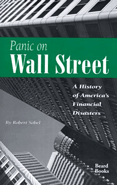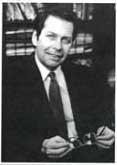
|
Panic on Wall Street: A History of America's Financial Disasters
By Robert Sobel
1999/12 - Beard Books
1893122468 - Paperback - Reprint - 478 pp.
US$34.95
The financial panics analyzed in this book illustrate the complexity of such events and that the causes are varied: political, military, economic, and even psychological.
Publisher Comments
Here is a book dealing with a subject endemic to many Eastern and Western countries — financial panic. Covering 12 of the most harrowing moments in American financial history from 1792 to 1962, it demonstrates that Wall Street and the public are at once the heroes, villains, and victims of past panics.
From the back cover blurb:
... The episodes depicted were dramatic, had an impact on Americans of the time, and have generally been neglected by other financial historians. Some of the most notable are the Western Blizzard of 1857, the Great Crash of 1929, and the Kennedy Slide of 1962. Not all were catalysts for depressions, but they illustrate the complexity of such events and that the causes are varied: political, military, economic, and even psychological. This book is fascinating reading for anyone who fears that we could suffer through another financial panic. 
Review by Gail Owens Hoelscher
From Turnarounds and Workouts, January 15, 2001
"Mere anarchy is loosed upon the world, the blood-dimmed tide is loosed, and everywhere the ceremony of innocence is drowned; the best lack all conviction, while the worst are full of passionate intensity."
What a terrific quote to find at the beginning of a book on financial catastrophe! First published in 1968, Panic on Wall Street covers 12 of the most painful episodes in American financial history between 1792 and 1962. Author Robert Sobel chose these particular cases, among a dozen or so others, to demonstrate the complexity and array of settings that have led to financial panics, and to show that we can only make "the vaguest generalizations" about financial panic as a phenomenon. In his view, these 12 all had a great impact on Americans of the time, "they were dramatic, and drama is present in most important events in history." They had been neglected by other financial historians. They are:
William Duer Panic, 1792
Crisis of Jacksonian Finances, 1837
Western Blizzard, 1857
Post-Civil War Panic, 1865-69
Crisis of the Gilded Age, 1873
Grant's Last Panic, 1884
Grover Cleveland and the Ordeal of 1893-95
Northern Pacific Comer, 1901
The Knickerbocker Trust Panic, 1907
Europe Goes to War, 1914
Great Crash, 1929
Kennedy Slide, 1962
Sobel tells us there is no universally accepted definition of financial panic. He quotes William Graham Sumner, who died long before the Great Crash of 1929, describing a panic as "...a wave of emotion, apprehension, alarm, It is more or less irrational. It is superinduced upon a crisis, which is real and inevitable, but it exaggerates, conjures up possibilities, takes away courage and energy."
Sobel could find no "law of panics" which might allow us to predict them, but notes their common characteristics. Most occur during periods of optimism ("irrational exuberance?"). Most arise as "moments of truth," after periods of self-deception, when players not only suddenly recognize the magnitude of their problems, but are also stunned at their inability to solve them. He also notes that strong financial leaders may prove a mitigating factor, citing Vanderbilt and J,P. Morgan.
Sobel concludes by saying that although financial panics have proven as devastating in some ways as war, and while much research has been carried out on war and its causes, little research has been done on financial panics. Panic on Wall Street stands as a solid foundation for later research on the topic.

 Robert
Sobel was born in 1931 and died in 1999. He was a prolific historian of
American business life, writing or editing more than 50 books and hundreds
of articles and corporate profiles. He was a professor of business at
Hofstra University for 43 years and held a Ph.D. from New York University.
Besides producing books, articles, book reviews, scripts for television
and audiotapes, he was a weekly columnist for Newsday from 1972 to 1988.
At the time of his death he was a contributing editor to Barron's
Magazine. Robert
Sobel was born in 1931 and died in 1999. He was a prolific historian of
American business life, writing or editing more than 50 books and hundreds
of articles and corporate profiles. He was a professor of business at
Hofstra University for 43 years and held a Ph.D. from New York University.
Besides producing books, articles, book reviews, scripts for television
and audiotapes, he was a weekly columnist for Newsday from 1972 to 1988.
At the time of his death he was a contributing editor to Barron's
Magazine.
 Other Beard
Books by Robert Sobel Other Beard
Books by Robert Sobel
|

|
Introduction |
3 |
| 1. |
William Duer and the Panic of 1792 |
8 |
| 2. |
The Crisis of Jacksonian Finances: 1837 |
32 |
| 3. |
The Western Blizzard of 1857 |
77 |
| 4. |
The Circus Comes to Town: 1865-69 |
115 |
| 5. |
Crisis of the Gilded Age: 1873 |
154 |
| 6. |
Grant's Last Panic: 1884 |
197 |
| 7. |
Grover Cleveland and the Ordeal of 1893-95 |
230 |
| 8. |
The Struggle of the Titans: The Northern Pacific Corner of
1901 |
273 |
| 9. |
The Knickerbocker Trust Panic of 1907 |
297 |
| 10. |
The Year the Stock Market Closed: 1914 |
322 |
| 11. |
1929: The Making of the Myth |
350 |
| 12. |
The Kennedy Slide: 1962 |
392 |
|
Conclusion |
427 |
|
A Note on Sources |
435 |
|
General Bibliography |
443 |
|
Index |
453 |
|
